Yellow spiders are a common sight in thick vegetation and even on flowers. These yellow spiders might appear poisonous to some predators due to their bright coloring.
Yellow spiders are a common sight on shrubs, on trees, or in the grass. They can be partially yellow or uniformly yellow.
Some of the most attractive yellow spiders are good pet spiders.
They are easy to spot in their enclosure where they add an exotic appeal.
Yellow spiders are common in North America, particularly in the Eastern parts of the continent.
They are also common in Europe in the Mediterranean area as well as in Northern parts of the continent which get more rain.
Some of the rarest yellow spiders are found in Asia in Thailand, Malaysia, Singapore, and India.
Table of Contents
Are Yellow Spiders Venomous?
Yellow spiders found in North America are both venomous and non-venomous.
Their venomous bite is dependent on their species rather than being dependent on other factors such as coloring.
Some yellow spiders such as the Wasp spider are only mildly venomous.
This means these spiders are only venomous to small prey such as insects and not to people.
Yellow spiders can sometimes change their color as it’s the case with Crab spiders.
An evolutionary trait allows these rare spiders to adapt their coloring depending on their immediate surroundings.
Yellow spiders that live on flowers tend to change or adapt colors to the color of the flower they live on.
This allows them to maintain camouflage waiting for prey to come close to the flower.
Other yellow spiders such as the Wasp spider mimic wasps so that they are perceived as threatening to potential predators.
The following spider species are known to have an expansive habitat and a mostly yellow body color.
19 Types of Yellow Spiders
1. Yellow Garden Spider
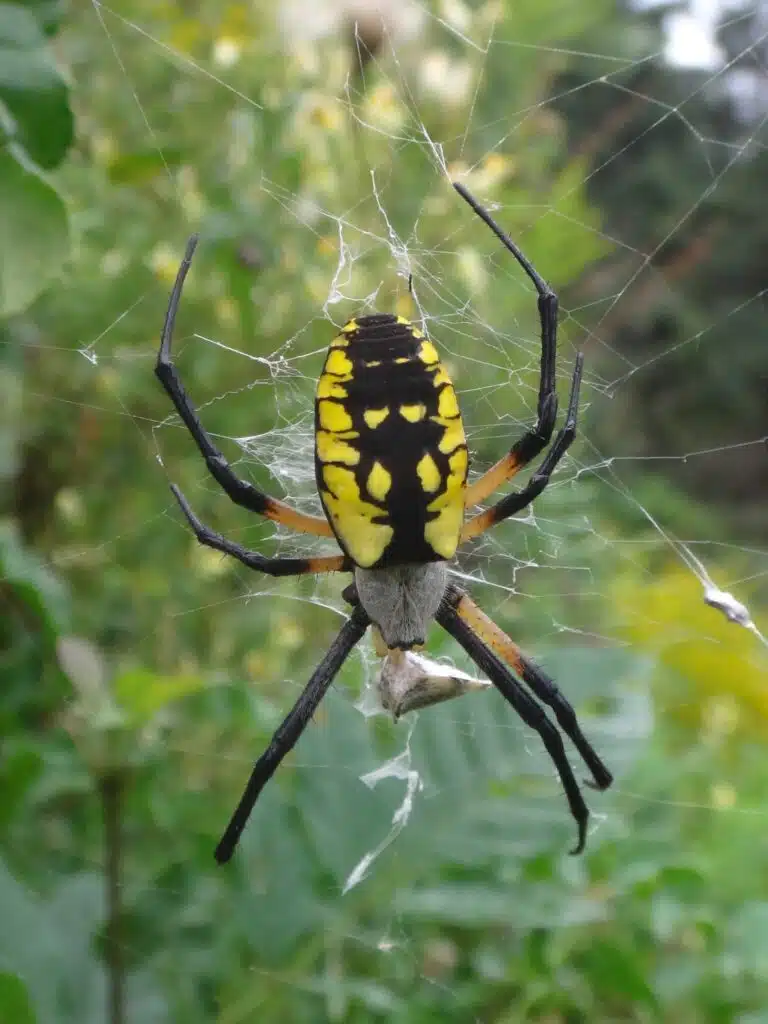
Scientific name: Argiope aurantia
Common name: Yellow garden spider, black and yellow garden spider, golden garden spider, writing spider, zigzag spider, zipper spider, black and yellow argiope, corn spider, Steeler spider, or McKinley spider
The Yellow Garden spider is one of the most common yellow spiders in North America.
This species is characterized by a dual-color body that’s both yellow and black.
Spiders of this genus have yellow markings on the abdomen and the cephalothorax.
The legs might also appear partially yellow but they are red-brown upon close inspection and slightly darker than the yellow marks on the body.
Only mildly venomous, the Yellow Garden spider has weak venom used against prey such as garden flies.
The Yellow Garden spider recreates its spider web each night.
2. Northern Yellow Sac Spider
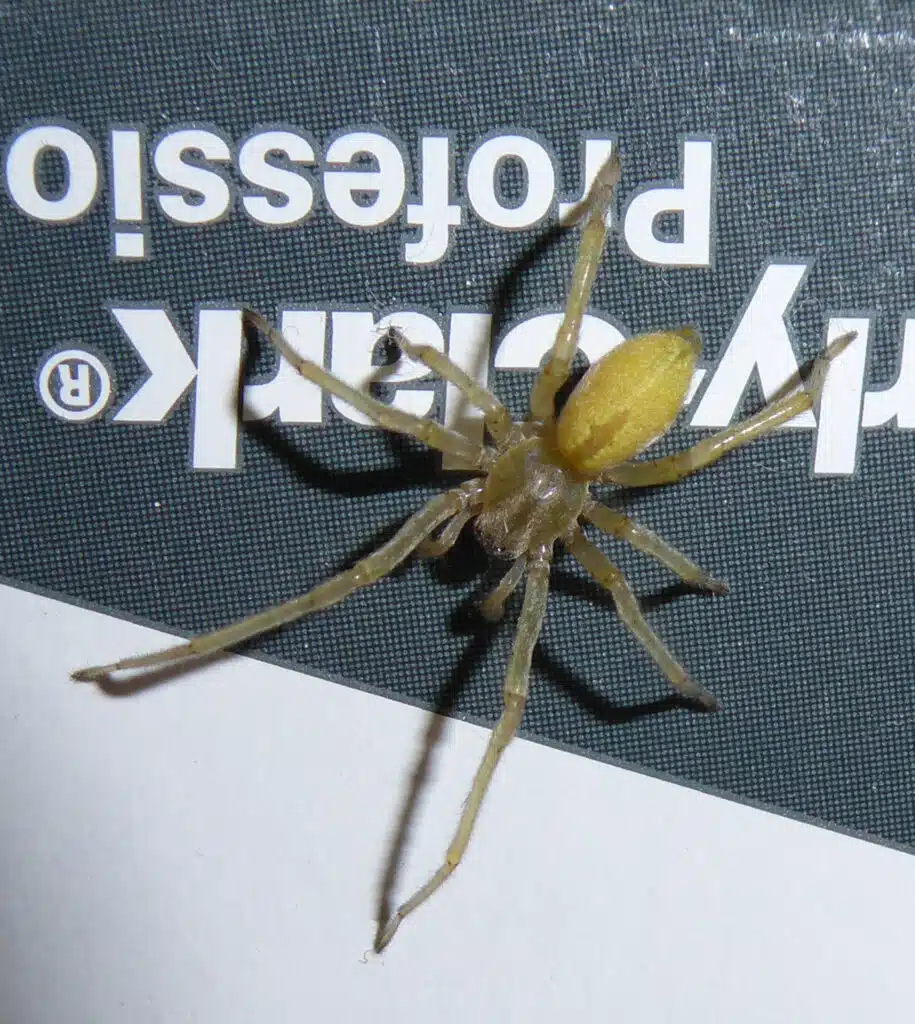
Scientific name: Cheiracanthium mildei
Common name: Northern yellow sac spider
The Northern Yellow Sac spider is commonly seen in a pale yellow or a pale green color. This spider grows to a size of 0.5 inches.
The Northern Yellow Sac spider is a very common species often believed to be the spider that bites humans the most.
This pale-yellow spider is known to cause pain with its bite. The pain is sharp but it doesn’t lead to any other complications outside skin-level reactions.
Edema and red skin are common following a Northern Yellow Sac spider bite.
3. Crab spiders
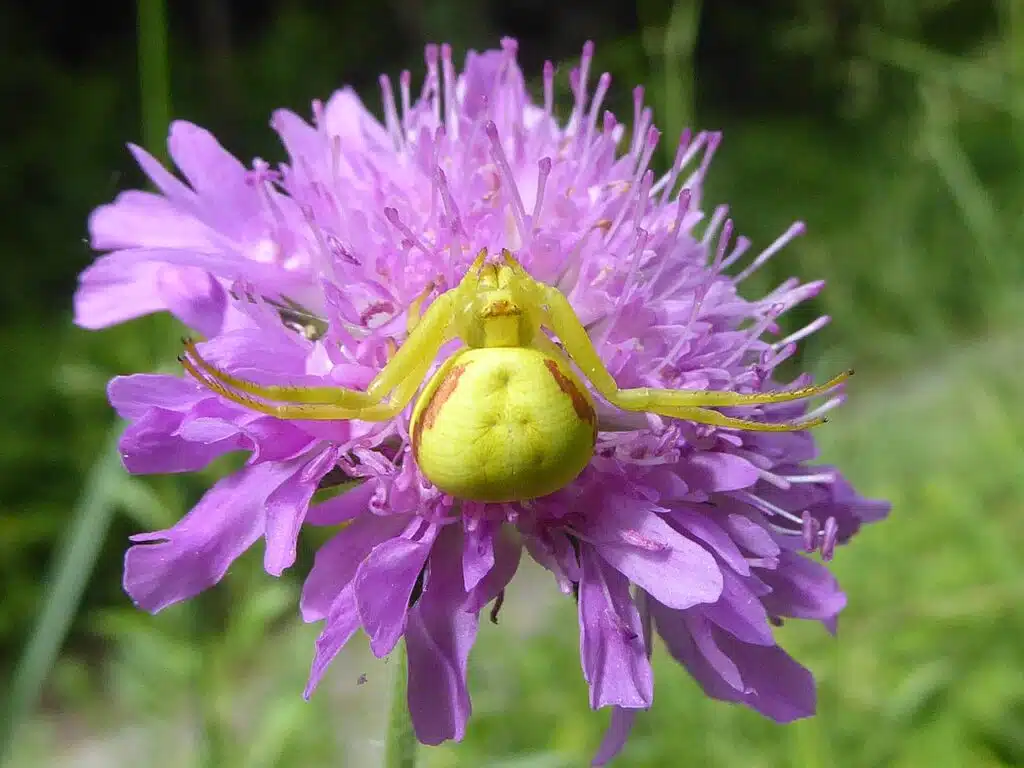
Scientific name: Misumena vatia
Common name: Crab spiders, goldenrod crab spider, flower spider
Crab spiders are an atypical species that can change colors from white to yellow and back.
The name of the species comes from the crab-like appearance and movements of the spider.
This coloring is fairly typical to female crab spiders as males can have a purple color.
The capacity to change colors is used by this species when it comes to the flowers it inhabits waiting for prey.
It changes colors so that it resembles certain flowers visited by pollinating insects it feeds on.
Young spiders of this genus can be white with red stripes. They adapt to a light appearance as they mature.
4. Wasp Spider
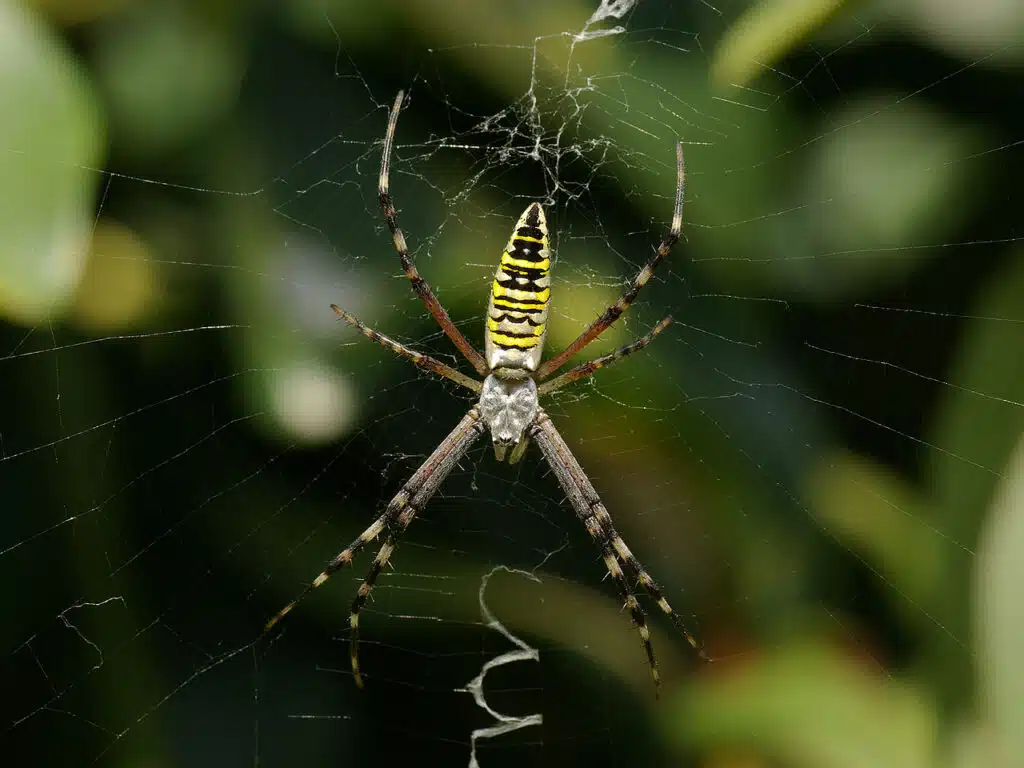
Scientific name: Argiope bruennichi
Common name: Wasp spider
The Wasp spider is believed to mimic a classic wasp in its coloring.
Wasp spiders have alternating black and yellow coloring which makes them resemble wasps and appear more threatening to possible predators as they sit on their zig-zag spider web all day.
The Wasp spider has a bulbous abdomen wider than its cephalothorax.
This species is also mildly venomous.
It awaits for various flies to get caught up in its spider net before it moves on to inject venom into the insects.
This venom paralyzes the prey essentially stopping a quick escape.
Wasp spiders are a common sight in gardens, parks, and grassland.
5. Marbled Orbweaver
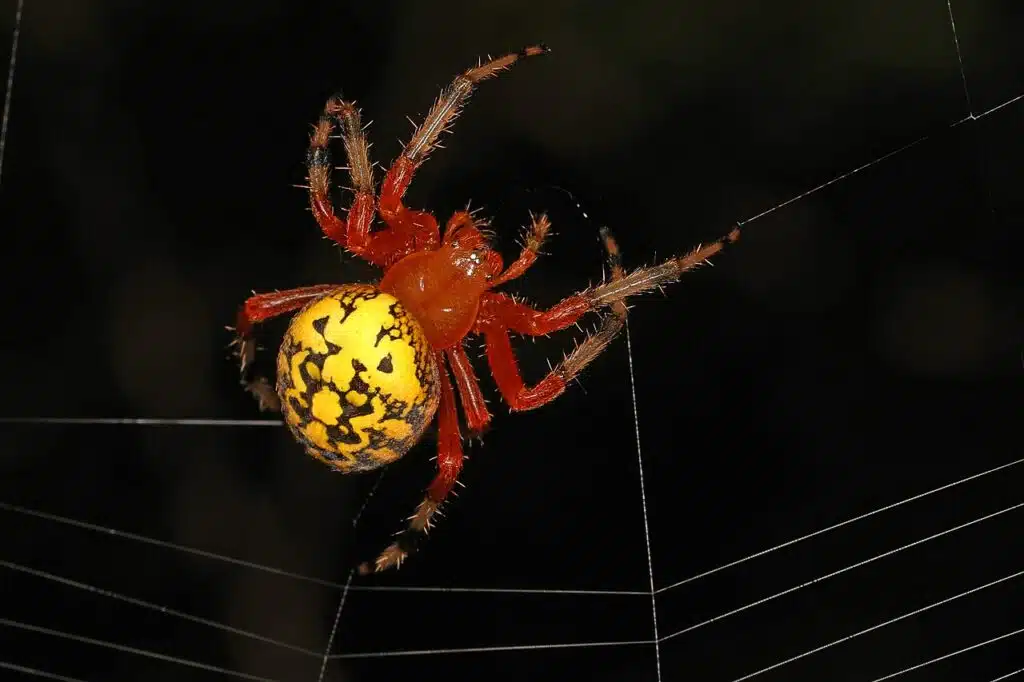
Scientific name: Araneus marmoreus
Common name: Marbled orbweaver, pumpkin spider
Marbled Orbweavers get their names to form resembling a marked piece of marble.
These spiders come in all types of bright colors including yellow and orange.
A common morph of the species includes a Yellow Marbled Orbweaver. The yellow coloring dominates the cephalothorax while its legs are mostly orange with black marks.
This spider also comes in an orange-dominating version where yellow marks are common across its body.
Common on trees and in shrubs, the Marbled Orbweaver is one of the common yellow spiders in North America, Europe, and Asia.
Growing up to 18mm, the Marbled Orweaver is also one of the largest bulbous yellow spiders in North America.
6. Arrowhead Orbweaver
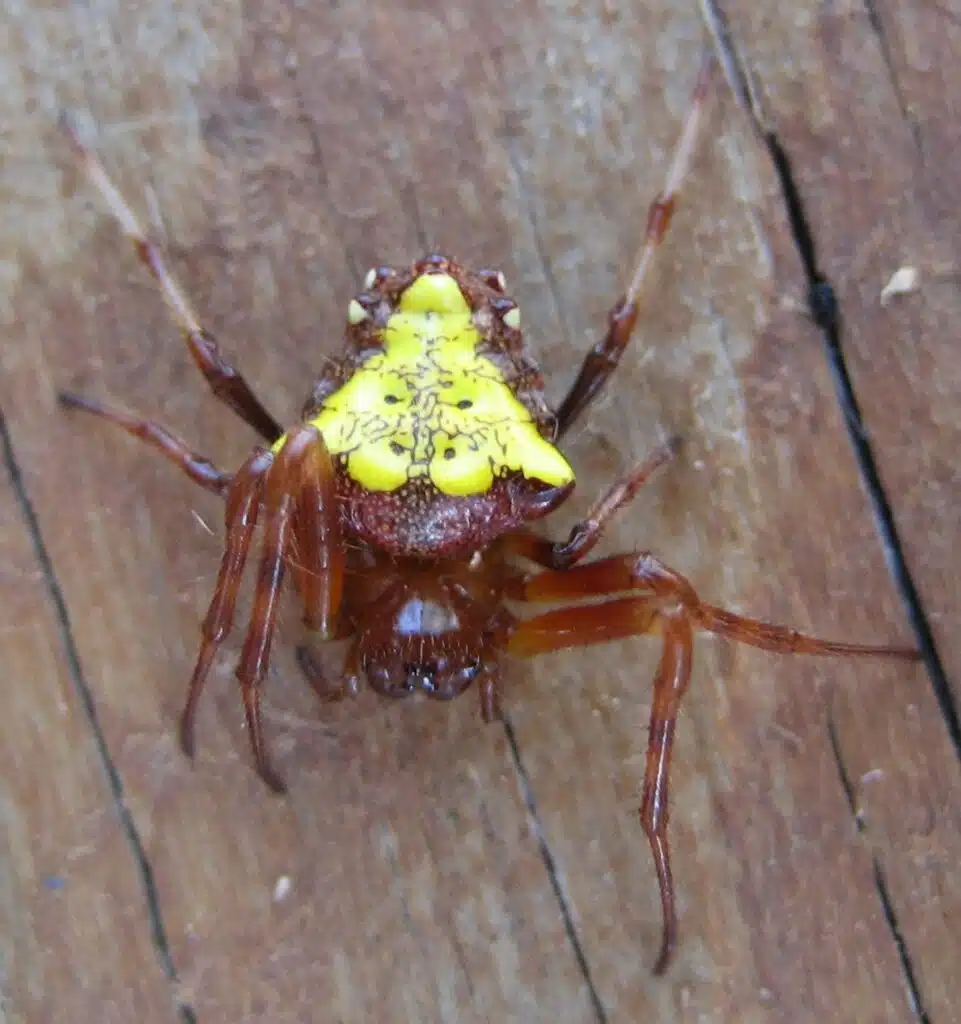
Scientific name: Verrucosa arenata
Common name: Arrowhead orbweaver, arrowhead spider, triangle orb weaver
Arrowhead Orbweavers are among the few Orbweaver spiders that don’t have a round abdomen.
These spiders have an abdomen that looks like the tip of an arrow, a shape that inspires their name.
Coloring on the top of the abdomen differs from one habitat to another and it includes a bright yellow morph, along with a white or even a red variable.
The rest of the body is tan or light brown but the species appears yellow as this spider mostly sits with its legs tucked under its body.
Arrowhead Orbweavers are common in woodlands where they spin webs they sit on all day.
These spiders don’t hang upside down as they prefer to sit with their heads high on their spider silk webs.
7. Jorō Spider
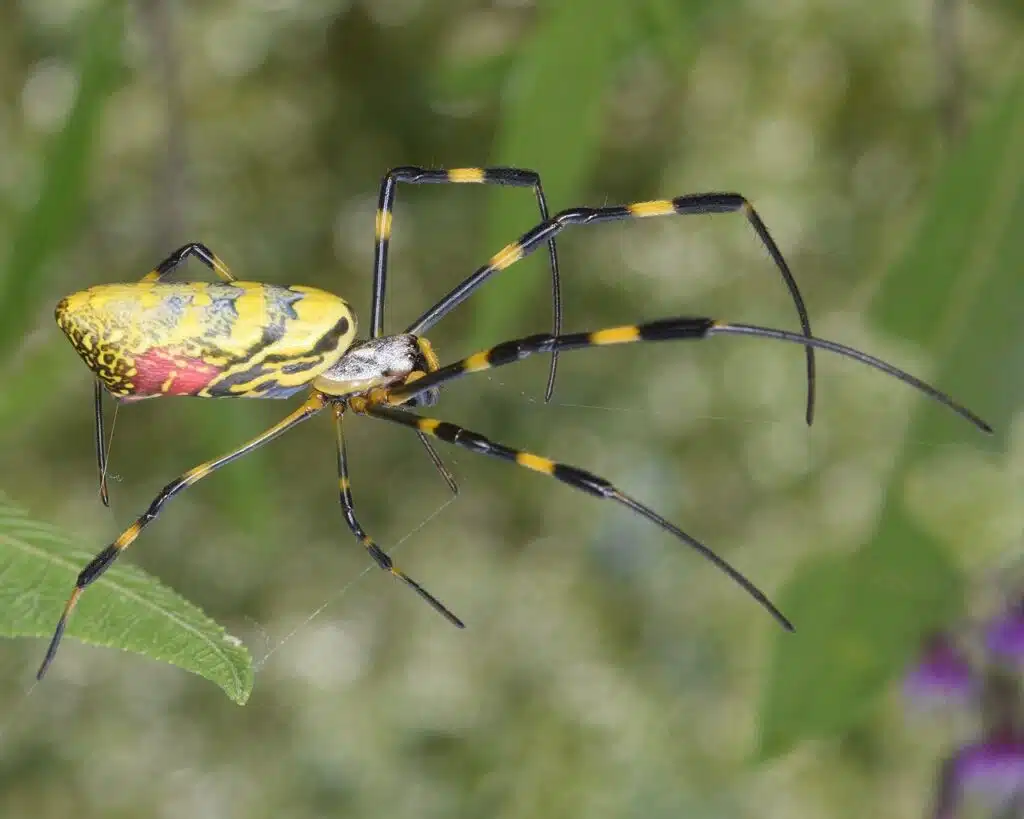
Scientific name: Trichonephila clavata
Common name: Jorō spider
This type of spider is characterized by yellow and blue horizontal stripes. It also has yellow marks on its long thin black legs.
Spiders of this genus can look completely different when it comes to the differences between males and females.
It’s the females that are mostly yellow as males are tan or even brown.
Spiders of this genus are also known for moving along with air currents similarly to balloons.
They can be seen hovering or moving like a balloon close to the ground.
8. Six-spotted Orbweaver
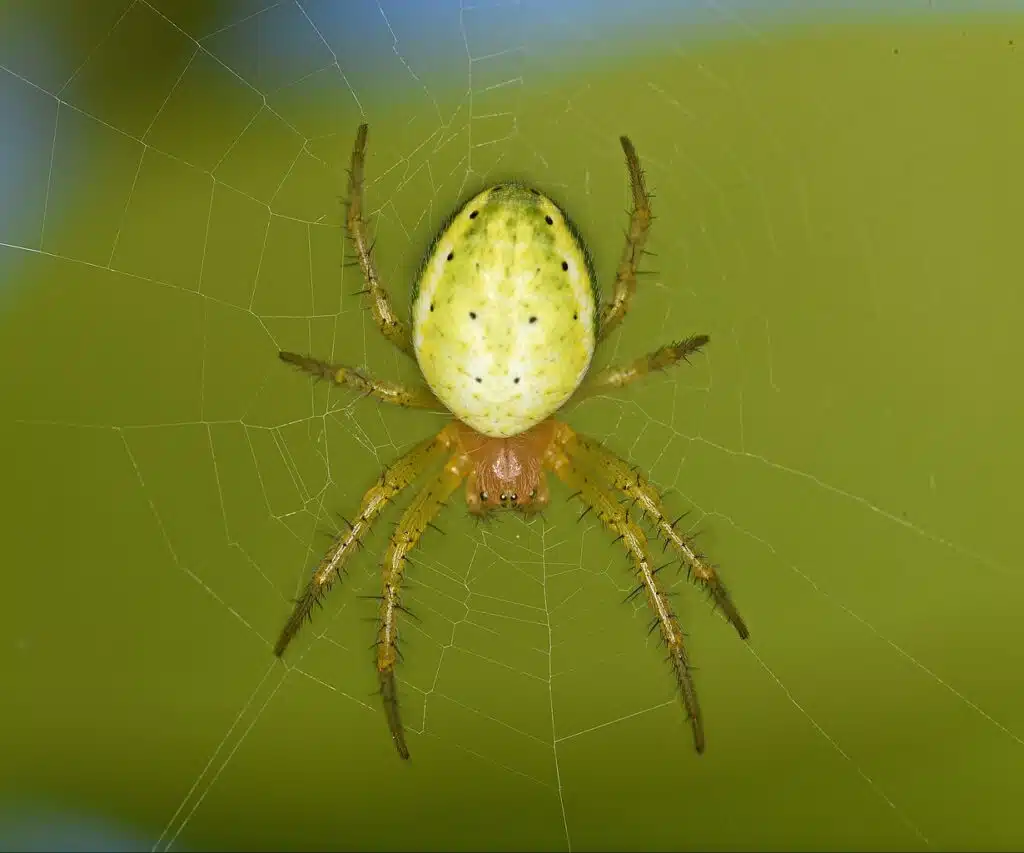
Scientific name: Araniella displicata
Common name: Six-spotted orbweaver
The Six-spotted Orbweaver is a species of spider known for its wide yellow abdomen with brown spots or dots.
The rest of the body is brown or light brown.
Spiders of this genus aren’t that common in gardens or parks. Most prefer to live in the woodlands.
Woodlands with leaves on the ground are preferred by the Six-spotted Orbweaver. These leaves are perfect for them to hide in and try to catch small insects.
9. Common Candy-striped Spider
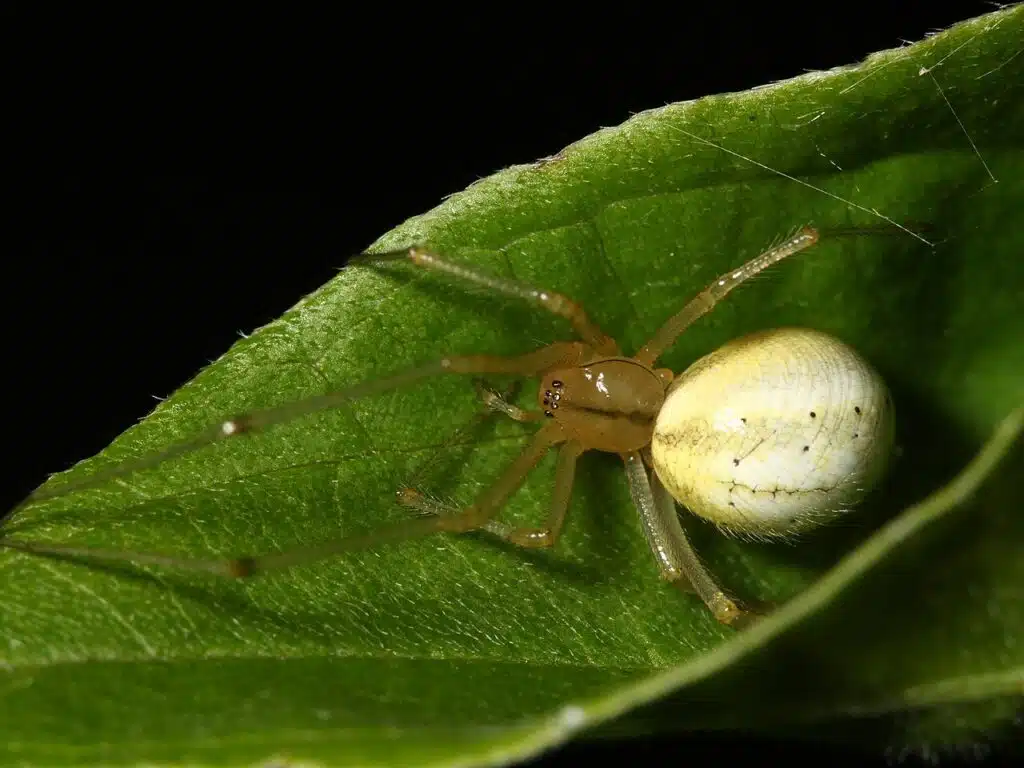
Scientific name: Enoplognatha ovata
Common name: Common candy-striped spider
Common Candy-striped spiders come in multiple colors including yellow and green.
This species is mostly referred by color by the color of its abdomen as the rest of the body is generally green.
As a result, a yellow Common Candy-striped spider has a yellow abdomen, a green head, and green legs.
Spiders of this genus have a globular abdomen that takes on the color of the plant or flower they live on.
Common Candy-striped spiders are found mimicking flowers for camouflage so they can catch insects feeding on flower nectar.
10. Cricket-bat Orbweaver
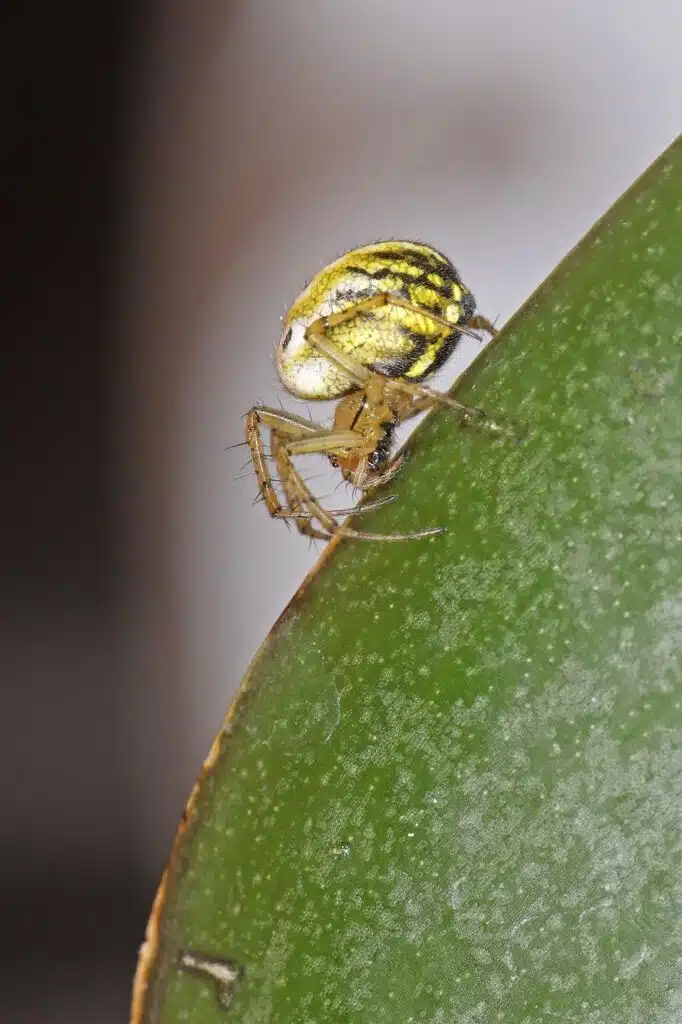
Scientific name: Mangora acalypha
Common name: Cricket-bat orbweaver
The Cricket-bat Orbweaver is a species common in Europe, North Africa, and Asia.
Spiders of the family are known for their globular abdomen which is sometimes yellow and other times white, black and yellow.
The rest of the body is red-brown.
Spiders of this genus can be further distinguished from other species by their sharp thick hairs seen across the legs.
11. Arrow-shaped Orbweaver
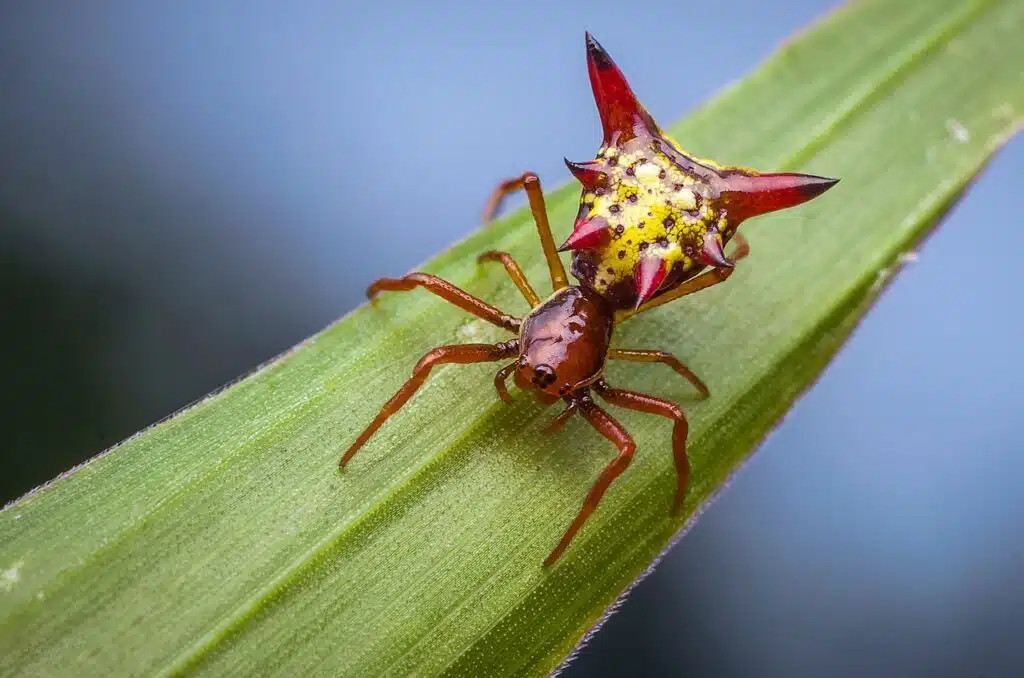
Scientific name: Micrathena sagittata
Common name: Arrow-shaped orbweaver, arrow-shaped micrathena
Often seen in gardens and woodlands, the Arrow-shaped Orbweaver is a species of yellow spider shaped like an arrow.
This spider doesn’t have a globular abdomen but an abdomen with 2 tips similar to an arrow.
Yellow is the main color of this pointed abdomen.
Red-brown abdominal projections are also distinguished at the edges of the abdomen.
These abdominal projections have the same color as the head and the legs of the spider.
Spiders of this genus are only mildly venomous. They aren’t venomous to people but they can paralyze small prey.
These small spiders only eat small insects such as mosquitoes.
12. Cucumber Green Spider
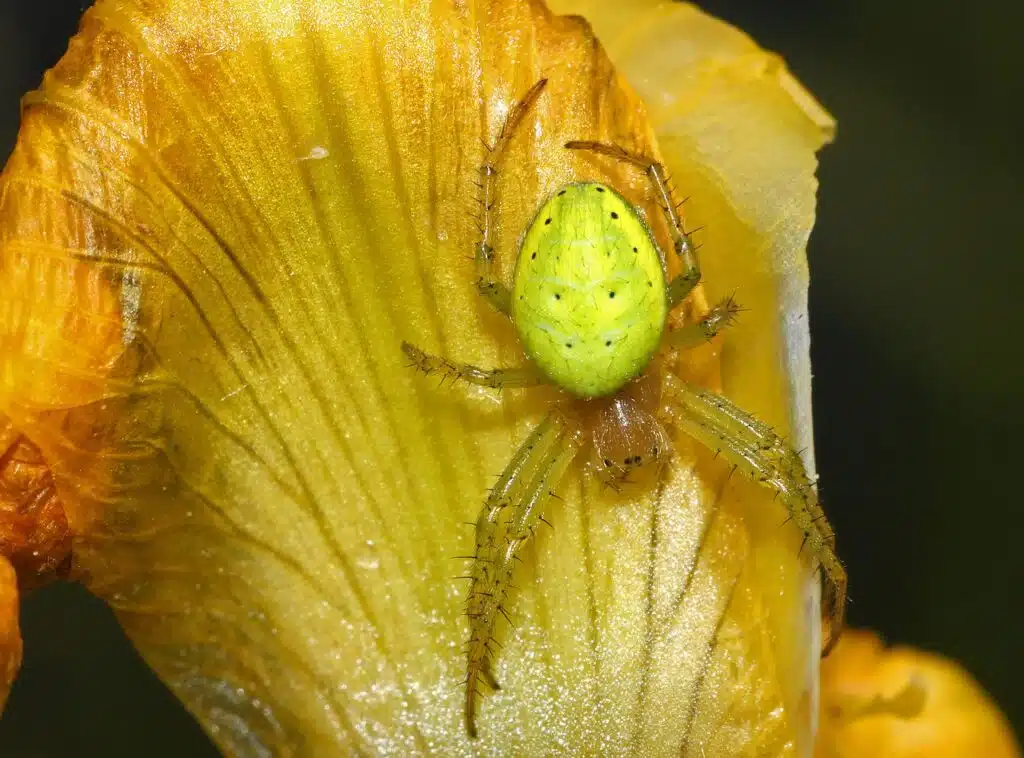
Scientific name: Araniella cucurbitina
Common name: Cucumber green spider
The Cucumber Green spider is a common species in Europe and Asia.
This species is commonly found in a yellow-colored abdomen as well as in a green abdomen color as it mimics its surroundings.
Cucumber Green spiders are found on crops where they build small spider web weaves where between leaves to catch insects.
Most of these spiders don’t even hide behind leaves like other species.
Their camouflaging coloring helps them remain undetected even when hiding in plain sight.
The females of the species are responsible for building spider webs. Female Cucumber Green spiders can grow up to 9.5mm.
Females of the species are a common sight due to their long season.
They can be seen up to September.
Males remain elusive. They have a shorter life cycle and they are seen only until July.
13. Green Huntsman Spider
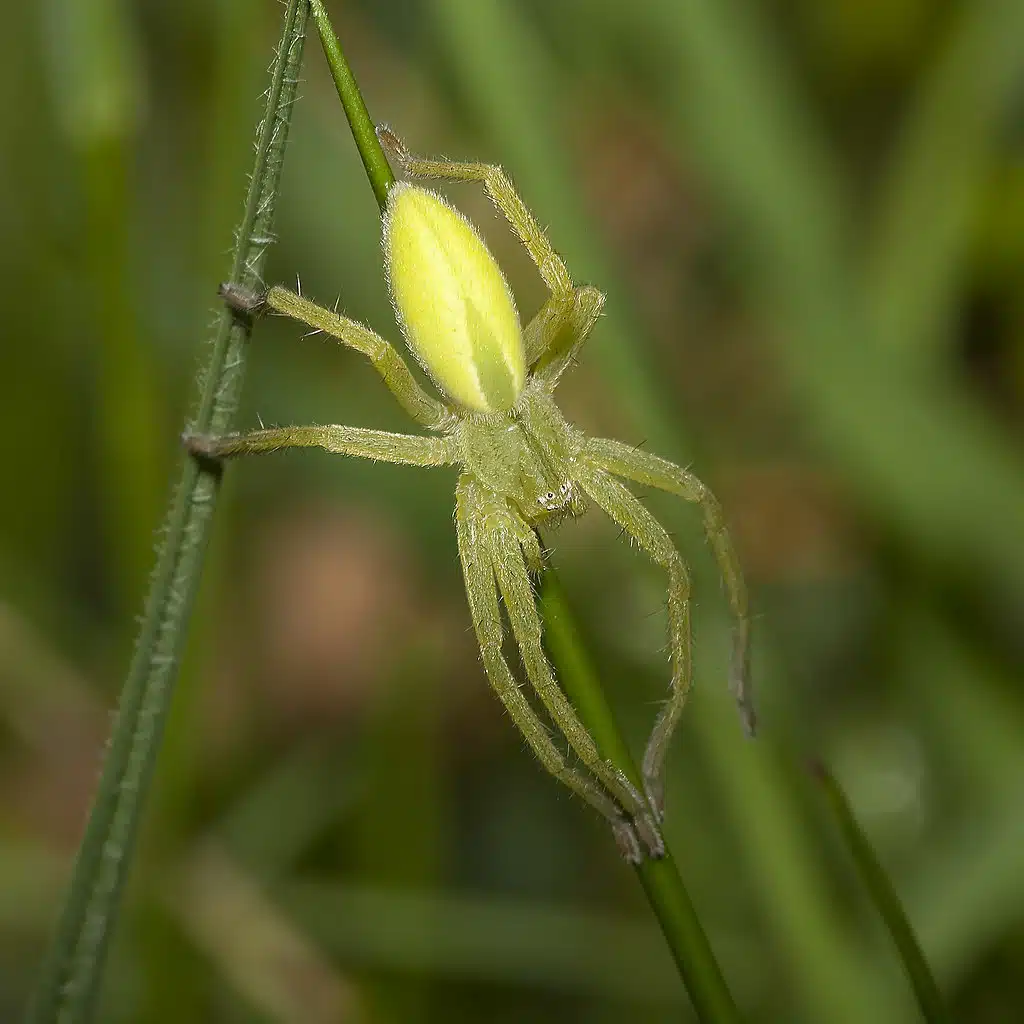
Scientific name: Micrommata virescens
Common name: Green huntsman spider
The Green Huntsman spider is a common sight in Europe. This species is known for its vivid green color.
Young Green Huntsman spiders are almost completely yellow.
Some morphs of this species can also be green with a yellow undertone as adults. The color of the adult mainly depends on its environment.
The Green Huntsman spider relies on its color for camouflage.
Spiders found in forests are more likely to be yellow compared to the Green Huntsmans found in grassland and other habitats.
Spiders of this genus live long lives meaning they are yellow for a long time as well. It takes up to 18 months for these spiders to mature and turn green.
14. Amazon Thorn Spider
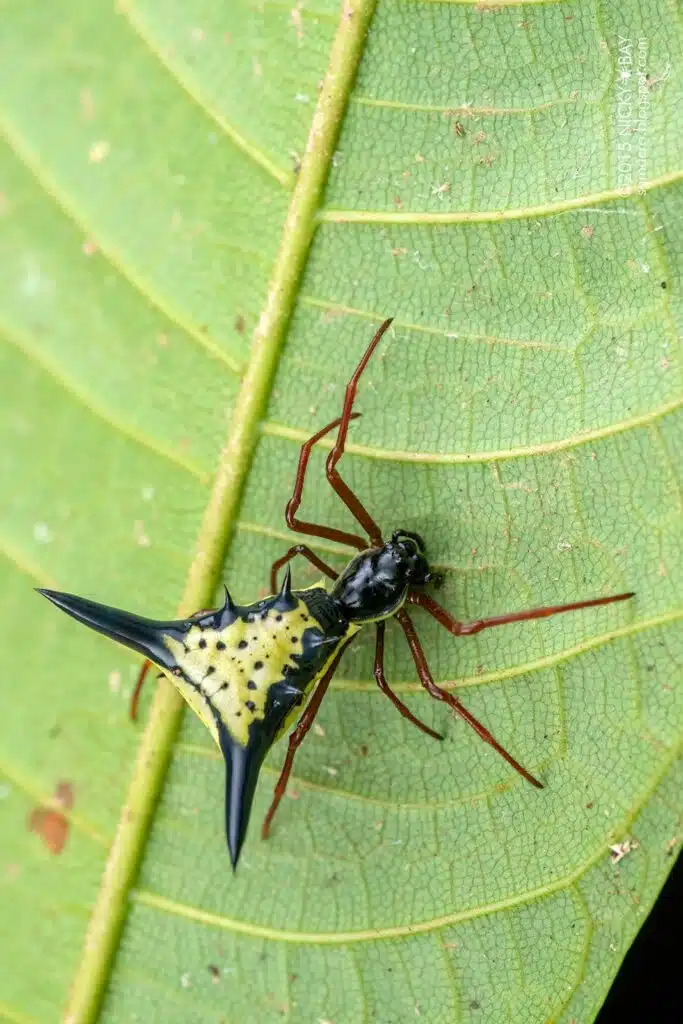
Scientific name: Micrathena schreibersi
Common name: Amazon thorn spider
This Micrasthena genus spider is common in South America. The spider has an arrow-shaped abdomen.
Coloring on the top of the abdomen varies and it’s mostly yellow.
The abdomen is black on the sides where black abdominal projections similar to spikes are also distinguishable.
These projections can deter potential predators.
The lower part of the yellow abdomen is black and red-orange.
Yellow is also seen on the sides of the head, unlike other spiders that have a yellow abdomen but a contrasting color head.
The legs of this spider are hairless and shiny black.
Spiders of the Amazon Thron genus are mildly venomous. Its bite doesn’t have an impact on humans but it paralyzes small insects.
These spiders build spider webs they use to catch prey. Once insects are caught up, they inject venom into it which paralyzes the insect.
This allows the Amazon Thron spider to eat the catch on the spot or later.
15. Hasselt’s Spiny Spider
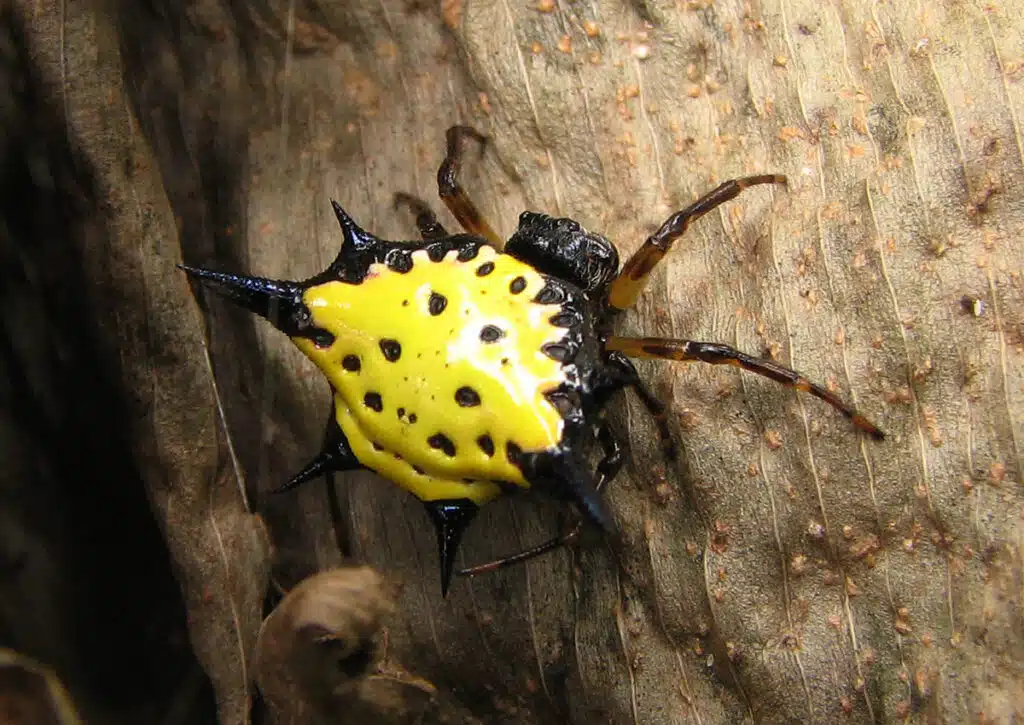
Scientific name: Macracantha hasselti
Common name: Hasselt’s spiny spider
This triangular spider species is native to Indonesia, Malaysia, and Thailand.
It has a very distinct shape and vivid yellow coloring.
Like most yellow triangular spiders, Hasselt’s Spiny spider is only yellow on the abdomen while the rest of the body is black.
The yellow abdomen also shows black spots. The legs of the species are also yellow, a rare sight in the world of orbweaver spiders.
This spider species is also known as the 12-spotted spider in certain areas as it has 12 small black spots on its yellow body.
Females of the species are larger than males as they grow up to 8mm.
They are a rare sight together with males as they prefer to inhabit wasteland. Remote areas are preferred by this species even if some spiders are found in woodlands.
Bukit Timah Nature Reserve near Singapore is the place where the species is the easiest to see in its natural habitat.
16. Pretty Orbweaver
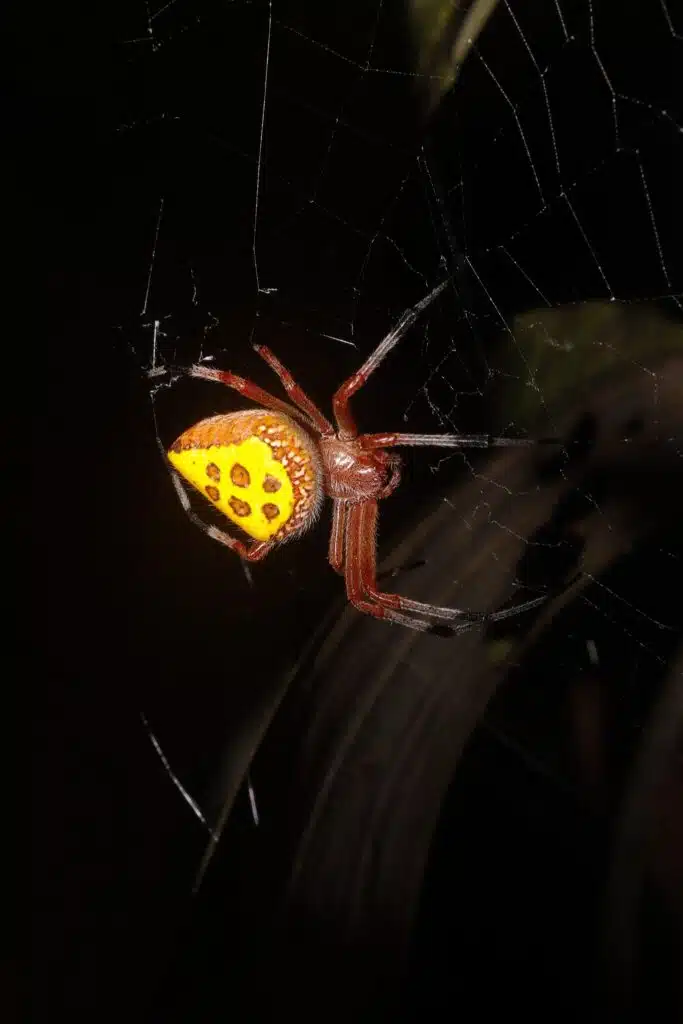
Scientific name: Eriophora nephiloides
Common name: Pretty orbweaver
This orbweaver species is common in Australia, North America, and South America.
It has different coloring depending on its region but a yellow morph is seen across the world.
Yellow coloring is specific to the abdomen that’s also covered in small white spots.
The species is also seen in a green abdomen color that has small pale-yellow spots.
Both the green and the yellow morphs of the species are known to stand out as the abdomen is bordered by a white line.
The legs of the species are red-brown.
Male Pretty Orbweavers are mostly brown and smaller than the females. Males grow to a maximum size of 0.66 inches while females can reach 1 inch.
In common gardens across Australia, this species is also known for laying eggs in a spider sac.
Spiderlings start to disperse as soon as they are born as the Pretty Orbweaver is a solitary species.
They use ballooning as a drifting or dispersing method.
Spiderlings eventually settle on leaves, twigs, or even on trees where they start to look for food.
The species lives up to 1 year in warm climates and up to 8 months in temperate climates.
17. Filmy Dome Spider
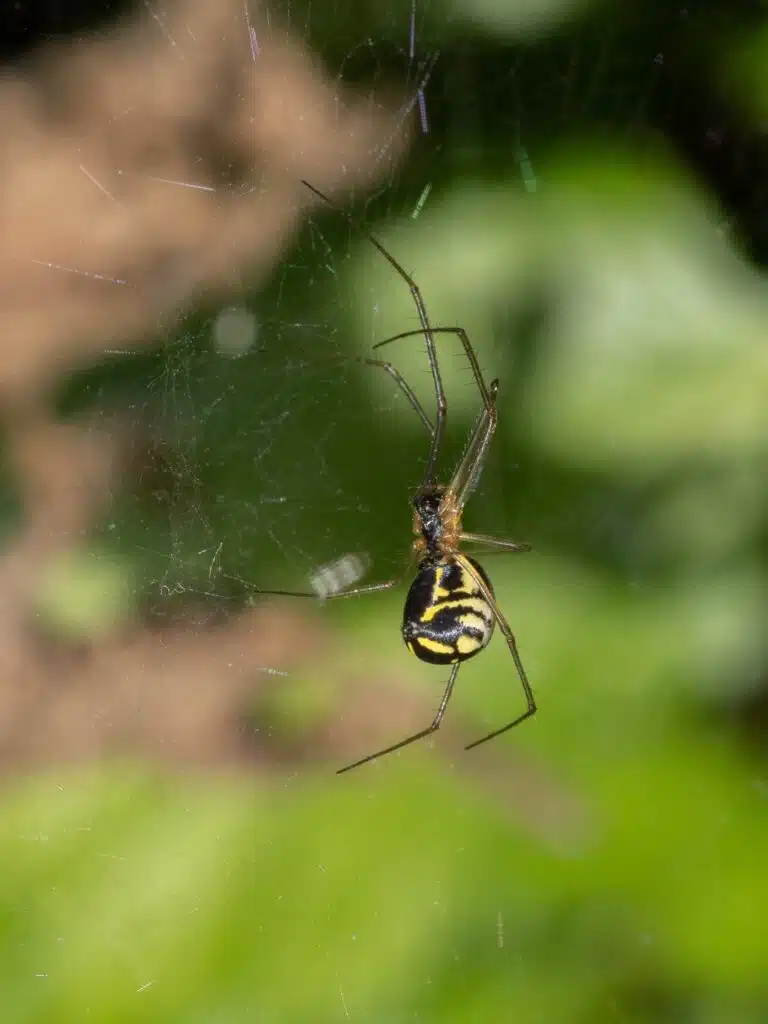
Scientific name: Neriene radiata
Common name: Filmy dome spider
The Filmy Dome spider is one of the beneficial yellow spiders in North America when it comes to its role in the ecosystem.
Filmy Dome spiders feed on gnats and mosquitoes, insects commonly found in homes, gardens, and other public places.
Spiders of this genus get their name from their dome-shaped abdomen.
This abdomen is both yellow and black. Yellow vertical and horizontal stripes of an irregular pattern are distinguishable on the abdomen.
A pale-yellow color is also distinguishable on the head of this species.
Its legs are mostly black.
This species grows to ¼ inches on average and it’s not known to come in other morphs.
18. Common stretch-spider
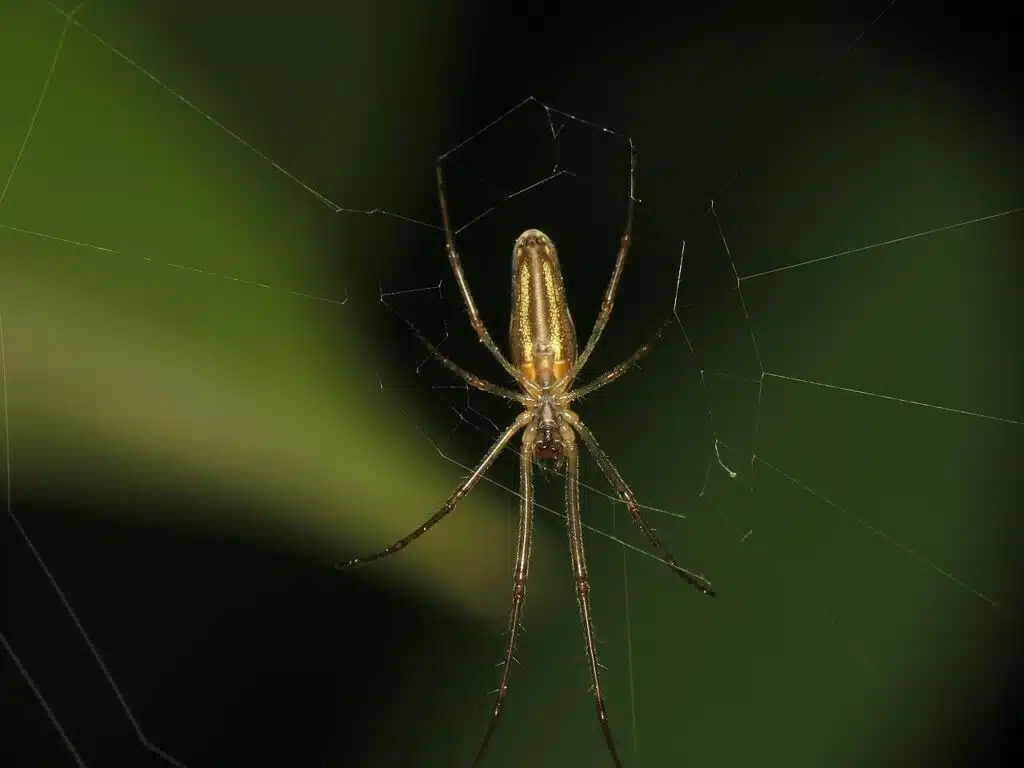
Scientific name: Tetragnatha extensa
Common name: Common stretch-spider
This elongated spider is common in the Northern Hemisphere, particularly in Northern Europe.
It comes in multiple colors but a dominant yellow version of the spider is common across the world.
This color is specific to the abdomen of the females which also exhibits a central lack line and other bright color spots.
Females are slightly larger than males. They grow up to 11mm while males grow up to 9mm.
This spider has a beneficial role in its prefer humid habitat.
It shares this habitat with mosquitoes that lay eggs in water and which also thrive in humid areas.
However, this spider also eats other insects, some of them larger than mosquitoes.
Moths often get caught up in their spider web and eaten by mosquitoes.
19. Phylloneta pictipes
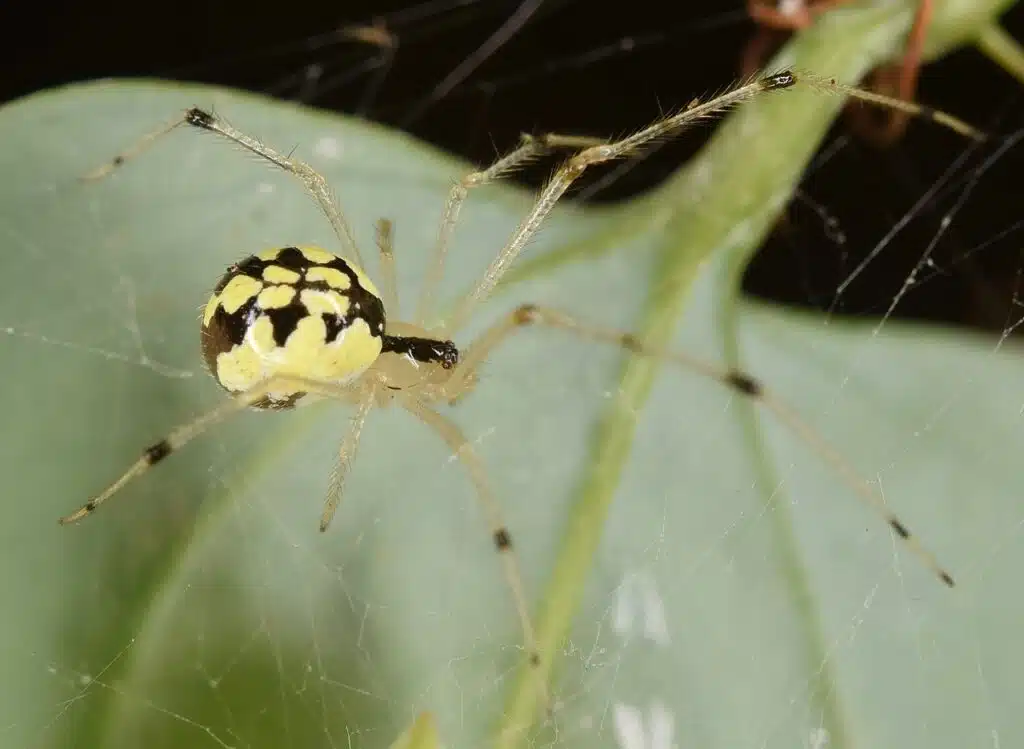
Native to Northeastern US states, this spider species is also known for its yellow color.
The dominant yellow is seen on the abdomen of the females which is also partly black.
Black marks can be distinguished on its dome-shaped abdomen.
These spiders also come in other colors such as lime and dark green. All of its morphs come with black marks on the abdomen.
Light translucent green is characteristic of its head and legs.
The spider is known to be pale yellow or even white until it reaches adulthood.